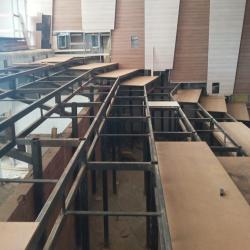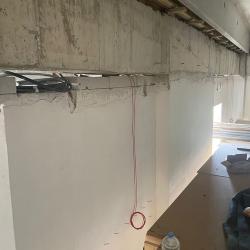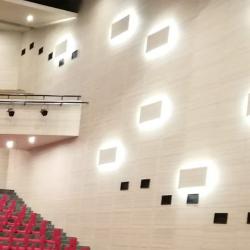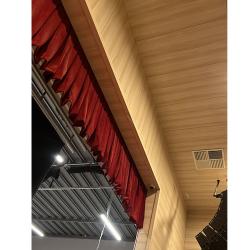Conference hall construction
The First Step in Conference Hall Construction: Planning
Building a conference hall is no easy task. Anyone can put up a stage and arrange some seats, but constructing a truly comfortable and functional hall is an entirely different matter. We've been in this business for years. From municipalities to private universities, from cultural centers to corporate meeting rooms—we’ve handled many projects. Our first rule is this: conference hall construction is not just about installing seats and a stage. It’s a system.
We always start with an on-site inspection. We take note of the hall’s width, ceiling height, slope, entrances and exits, and natural lighting. Is the space flat or will it need a tiered seating layout? How many people will it accommodate? Will it be used solely for conferences or for multipurpose events like theater, seminars, and film screenings? The answers to these questions guide us in designing the right system. If the planning isn’t done correctly from the start, every added element later becomes a problem.
Acoustic, Lighting, and Ventilation Solutions
Visual appeal is not enough when constructing a hall. If the speech cannot be clearly heard or attendees can't understand half the content, the hall is a failure. That's why acoustics is a critical step in conference hall construction. Everything from wall coverings to ceiling height affects sound. We often recommend sound-absorbing panels, special fabric wall treatments, and acoustic ceiling systems. These reduce echo and ensure clear speech transmission.
Lighting is another key issue. Stage lighting is calculated separately from audience area lighting. From LED projectors to spotlights, each detail must be planned for both energy efficiency and visual comfort. Ventilation often goes unnoticed, but it's actually crucial. If the air in the hall is heavy, no one can focus on the event. Ceiling-type air conditioning or centralized systems—whatever the choice, it must be planned in advance.
Seating Layout and Conference Chair Selection
Where do guests spend most of their time? On the conference seats, of course. That’s why choosing the right chairs is the heart of our job. Is the floor flat or stepped? How much legroom will there be between rows? Are accessible seating areas included? All these are decided during the seating layout stage of conference hall construction.
We don’t just choose a chair based on its color. We check foam thickness, fabric type, frame structure, and armrest material. We can produce special models with numbering, writing tablets, or foldable systems if needed. With fixed-mount seating, we ensure symmetry and functionality in the overall hall layout. A good chair not only seats the guest—it keeps them comfortable during long sessions.
Stage Design and Technical Infrastructure
A conference hall without a stage is incomplete. But placing a platform and a podium doesn’t mean the job is done. We always ask what kind of events will be held: speeches, theater performances, or live music? Each event type has different stage requirements. That’s why stage design is just as important as the hall in conference hall construction.
If it’s just for speeches, a 30–40 cm platform may be enough. But if there’s going to be a screen or LED wall behind, stage height must be adjusted. Technical infrastructure comes into play here. Will there be an under-stage sound system? Where will power cables run? How will microphone wires be hidden? All of this must be decided before construction begins. Stage lighting, control rooms, and audio desks are fundamental details that prepare the hall for professional use.
Conference Hall Construction Costs
The first question everyone asks is: “How much will it cost?” There’s no simple answer without measurements and design details. But here’s the truth: conference hall construction costs vary greatly depending on the quality and features selected. Some halls are for 50 people, others for 500. Some have flat floors, others are tiered. Every detail directly impacts the cost.
Chair models, fabric quality, stage setup, audio system, ventilation, and lighting—all of these are separate cost items. We always provide our clients with a transparent quote. We break it down: chairs cost this much, stage that much, technical setup another amount... This way, the client knows exactly what they’re paying for. If there’s a tight budget, we offer creative solutions—but never sacrifice quality. We’ve seen firsthand that cutting corners today leads to twice the cost tomorrow.
Project Delivery Process and Implementation Details
You can’t set up a hall in a day. But with a good plan, it can be completed quickly. We create a timeline from day one: when to measure, when installation begins, when testing happens, and when the hall is delivered. We present it all in writing. Because for us, a promise isn’t spoken—it’s signed. In conference hall manufacturing, disciplined execution is everything.
Our field teams are experienced. Everyone knows their role. Floor technicians, chair installers, and audio-visual staff all work in harmony. This is not a one-man job—it takes a skilled team. We never leave the site until we’re sure everything works. All equipment is tested, every chair is checked, every cable is tried. Only then do we clean the hall and hand over the keys. The final signature comes when everything is ready for use.
Our company, starting with the production of conference chairs and conference chair manufacturing, now also undertakes turnkey project planning, including conference hall construction.
Our journey, which began with conference chair manufacturing, has evolved with the experience gained over time. Continuing our services with furniture, stage curtains, and acoustic sound systems for conference halls, we now deliver your projects smoothly and in the shortest time with turnkey conference hall construction.
The conference hall chairs on our page are prepared according to the project or customer requirements. Since the products are specially made for an individual or venue, it is very difficult to use them in another venue, so returns are not possible for conference chairs.
As Bereket Office, spare parts for the conference chairs we manufacture are always available. In addition to plastic covers, conference chair spare parts for other companies are also available. The delivery time for spare parts may vary depending on the model and the requested quantity.
The production of conference chairs varies depending on the order quantity, the ordered model, and the workload at the time of the order. However, the average production time is 10 days.
The conference chairs, conference seats, and project-based products manufactured and listed on our page are guaranteed by our company for 2 years.
Since we do not keep conference chairs in stock and produce them upon order, they are manufactured in the colors and features you request.
We provide assembly services for a fee for the conference chairs we manufacture. Depending on workload, we also offer assembly services for products purchased from other companies.
Our conference chairs are offered in different sizes depending on the model. Generally, the seat width ranges from 45-55 cm, and the backrest height varies between 50-70 cm. For detailed measurements, you can contact our company for more information.
Depending on the process to be performed and the number of chairs, conference chair repair for existing conference chairs in conference halls is carried out by our company.
Our chairs are manufactured with high-quality fabric, leather, or synthetic leather upholstery. Durable metal or wooden materials are used for the frame. The foam filling is designed with high density for long-term comfort.
Fabric-upholstered chairs can be cleaned with a damp cloth and mild detergent. For leather or synthetic leather upholstery, special leather cleaners are recommended. Avoid abrasive chemicals.



